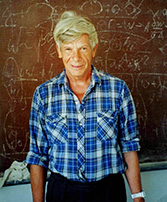Speaker
Description
We considered the Tsallis holographic dark energy model in frames of Nojiri-Odintsov gravity with $f(R)=R+\lambda R^2-\sigma{\mu}/{R}$. The equations describing the cosmological evolution in this case contain third derivative of the scale factor on time. Therefore this requires to impose initial condition on the second derivative $a$ (which is equivalent to the condition on $\dot{H}(0)$). The cosmological evolution of such universe is investigated for various initial conditions and values of parameters. The evolution of the universe is studied in detail for the case when $\dot{H}(0)$ coincides with the value in the standard cosmological model with $\Omega_\Lambda = 0.72$. Solutions have interesting feature namely Hubble parameter ``oscillates'' near dependence corresponding to THDE in General Relativity. The amplitude of this oscillations grows with time in future. For $\mu\neq 0$ a future singularity arises corresponding to zero of second derivative of $f(R)$ for some $R$. It is shown that for $\mu \neq 0$ appearance of singularities are typical and the time up to these singularities can be relatively small from cosmological viewpoint. The singularity is associated with the zero of second deribative of $f(R)$ on $R$. Dynamics of the universe in the past is not especially sensitive to this initial condition and is close to that in the model of holographic dark energy in the background of GTR (the differences appear only at times close to the initial singularity of the Big Bang). Our analysis shows that such models for some parameters can describe observational data for SN Ia and dependence $H(z)$ with sufficient accuracy especially for $\gamma=1$ and larger values of $\dot{H}$ in comparison with $\Lambda$CDM model. Also one note that $H(z)$ data are described better in frames of THDE on modified gravity backgroud. This means that the models considered by us can be quite realistic.

